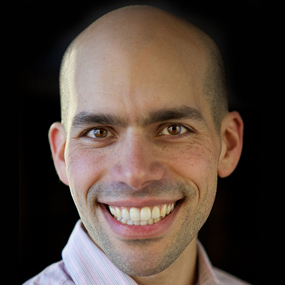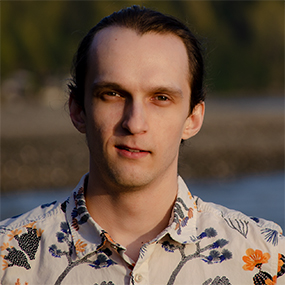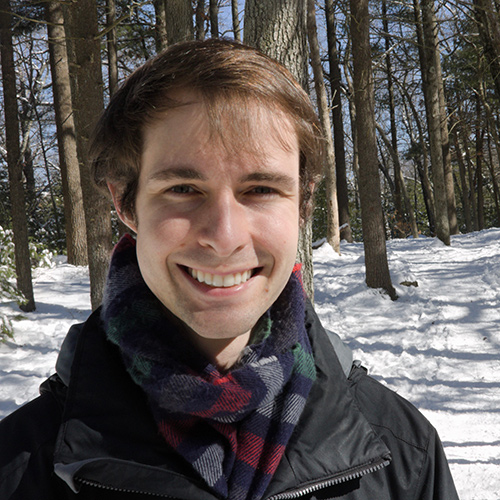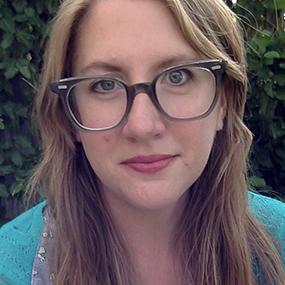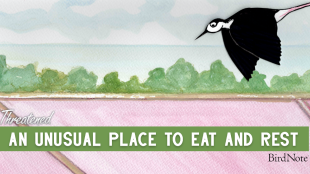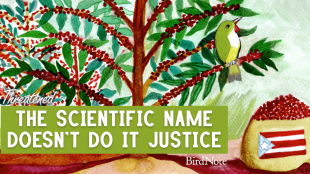

Join BirdNote tomorrow, November 30th!
Illustrator David Sibley and actor H. Jon Benjamin will face off in the bird illustration battle of the century during BirdNote's Year-end Celebration and Auction!
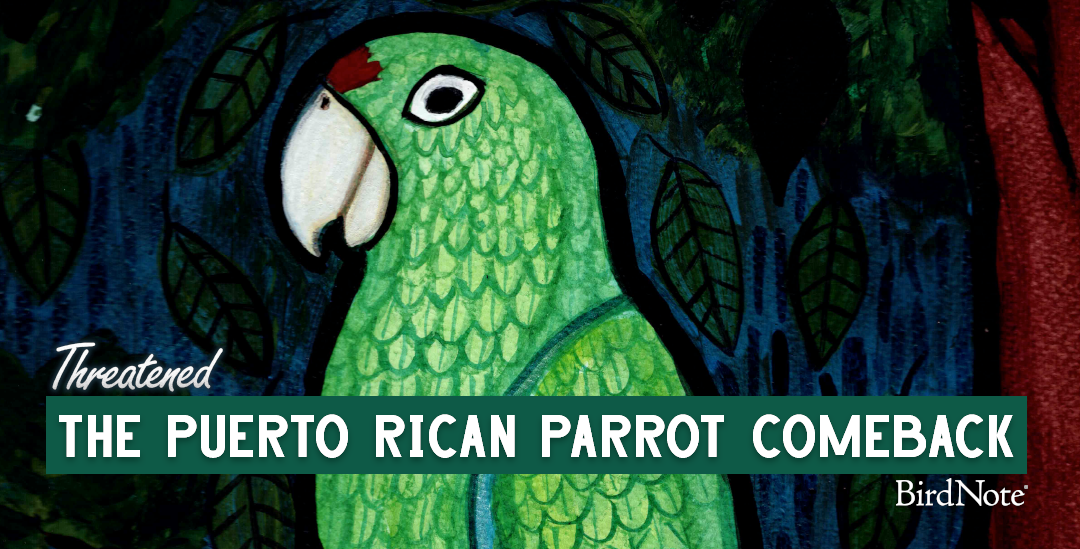
In the season premiere, we travel to Puerto Rico to meet a bird that has survived deforestation, hurricanes and the exotic pet trade. The Puerto Rican parrot saw its numbers drop to almost zero at one point. But today, its population is growing and stabilizing. To achieve this, the people involved had to make some difficult tradeoffs.
Listen to this episode of Threatened in Spanish here.
Ari Daniel: BirdNote Presents.
[Echoing Wingflaps SFX]
[Puerto Rican Folk music fades in: Puerto Rican Folk Sonoro]
[Fades out under narration]
Ari Daniel: This is a story of survival. The Puerto Rican Parrot — also known as the Puerto Rican Amazon — is endemic to Puerto Rico, and endangered. The birds have faced deforestation, hurricanes, and the exotic pet trade — driving their numbers to almost zero at one point. But today, remarkably, their population has come back, and it’s stabilizing. To get here, though, the people who allowed this achievement possible had to make some difficult tradeoffs. Today on Threatened, the story of how this parrot’s recovery is riddled with setbacks and triumphs, resilience and compromise. It comes to us from producer Mariana Reyes in Puerto Rico. I’m Ari Daniel.
[Reflective Threatened theme begins]
Mariana Reyes: Hi, Ari. How are you doing?
Ari Daniel: I'm good Mariana! So what drew you to the Puerto Rican Parrot in the first place?
Mariana Reyes: Well, there are, of course, here a lot of birds, 17 of which are endemic to Puerto Rico, which is not a large number. But I mean, we're an island that is a hundred by 35 miles. So it's a pretty small island. Um, the Puerto Rican Parrot within those 17 birds is, I think, one of the best known by the public even though many people have never seen one. When we were kids in the eighties, you would see green parrots flying around and we would think it was a Puerto Rican Parrot. But it wasn't, it was actually the Dominican or Hispaniolan Parrot. So getting a chance to go and actually see the parrot, it's not usual. You know, to be able to actually be in the same space with them. But the parrot has still become a national symbol right there with the Coquí frog, as an animal that represents Puerto Ricans because of their story of resilience. I wonder if we love our parrot because we identify with its struggle to survive.
[Puerto Rican Folk music fades in: Puerto Rican Folk Sonoro by Christian Nieves]
Mariana Reyes: So to get to know these birds and find out their story, I had to get out of the city.
I'm driving from San Juan to Río Abajo, a barrio located between the towns of Arecibo and Utuado. The trip is a little more than an hour and the road borders the coast before heading inland towards the mountains. I want to meet biologist Ricardo Valentín and his coworkers that are part of the conservation program led by the Department of Natural and Environmental Resources. Ricardo manages the Jose L. Vivaldi Aviary, where they keep the captive parrots. The effort has been very successful in recent years in their mission of breeding and protecting the Puerto Rican Parrot.
[Puerto Rican Folk music ends]
[Sound of car door opening. Car starts]
[Car pulls onto road]
Like I said, It is quite unusual to see one of these parrots outside certain areas of the island. The only parrots that I see on the way there are the ones painted on beach towels for sale by the road, Carretera número 2, alongside hammocks and wooden mortars to smash plantains.
The last segment of road is very narrow, surrounded by nothing but trees. Finally, I arrive at a gate in the middle of the forest. I get out of the car and call Ricardo on the intercom.
Mariana Reyes: Hola, estamos en la entrada.
[Ambi: Gate opens]
At the heart of Río Abajo, Ricardo’s home is surrounded by trees, and of course birds. Parrots aren’t usually friendly to humans, but Ricardo’s lived among them for 23 years, so they visit his wooden balcony, where they eat and roam freely.
On a tree by the balcony there is an artificial nest made of plastic and wood that serves as a breeding space for wild parrots. The parrots are his only neighbors and who Ricardo sees first thing in the morning.
Lucky for me, Ricardo is friendly to humans. Even though, like the parrots, he doesn’t see people often.
Ricardo Valentín: But there is a magical thing that helps me in this loneliness, and it’s called the internet.
Mariana Reyes: [Laughs] So do you have a good connection?
Ricardo Valentín: Yeah I pay a lot for it. I don’t know what I would do if I couldn’t argue with strangers.
Mariana Reyes: Online?
Ricardo Valentín: Online, because it can get really boring here. If you have to spend like 40 minutes driving just to eat an ice cream, you think, do I really want to eat an ice cream if I have to drive 80 minutes? No. So I spend most of my time here.
Ari Daniel: That's amazing. He's got to do a lot of meal prep, like meal planning.
Mariana Reyes: Right, I know!
Ari Daniel: I don't know, that just seems like a big logistical effort.
Mariana Reyes: But he did mention that he is very organized in that sense.
Ricardo Valentín: I buy a huge amount of groceries once a month. Sometimes once every two months.
[Bossa nova music starts]
Mariana Reyes: Ricardo has been living in Río Abajo with his friends the parrots since the late 90s. But for most of his life, Ricardo wasn’t around parrots at all. That’s because when he was a child, the population of parrots was very low. The modernization of the island, construction of suburban style homes and buildings took a toll on our forests. Even before that, by the end of the 19th century many trees were destroyed. By 1912, less than 1 percent of Puerto Rico’s forests were virgin. The old trees were torn down, trees that parrots rely on for their homes because they nest in holes in the trees trunks.
[Bossa nova music fades]
When the trees were torn down, the workers would take the parrot chicks out of their nests to sell in the exotic pet trade. So, it was a double whammy.
[Fast paced Puerto Rican Folk music fades in]
This was in the 1950s. It was a time when many Puerto Rican people were also trying to survive.
Ricardo Valentín: At those times, you go work for two weeks to earn 45 cents. And 45 cents could let you have a family, in poor condition, but you could survive. But a baby parrot could be sold for two dollars. So there was a premium. You could make some money that today would be like the salary of a month for a person selling the babies.
Mariana Reyes: Workers could sell a parrot chick for the equivalent of a month’s work of tearing down trees.
[Fast paced Puerto Rican Folk music fades out]
Ricardo Valentín: By the fifties, you could only find Puerto Rican Parrots around the east, around El Yunque Forest.
Ari Daniel: El Yunque, it’s a beautiful rainforest on the eastern side of the island, right?
Mariana Reyes: El Yunque was established as a federal forest many years ago, but it has always been protected because it was a sacred place for the tainos, our first inhabitants. El Yunque or yukiyu was their god of protection that would stop or fight the god of evil Juracan.
[Menacing Puerto Rican Folk music begins]
Ari Daniel: Wow, Juracan, that sounds like the word “hurricane.”
Mariana Reyes: Exactly, “hurricane” is a word derived from the Taino language, and it was used to name that force of nature that would destroy everything on its path. El Yunque served as a barrier for those hurricanes that entered the island from the East. In the 1900s, El Yunque was closed to the public and used for military operations. Many acres were logged during World War II, and it was used for radiation and agent orange testing for the Vietnam War. After efforts were directed towards preservation, decades ago, access was fairly easy. People could just walk in and enjoy nature or jump into the river. But ever since Hurricane María the federal authorities changed the system and it is now necessary to make reservations prior to every visit. And all of that is part of the complexity of our colonial history.
[Menacing Puerto Rican Folk music fades out]
Ari Daniel: Yeah it sounds like there was kind of a significant colonial influence at work.
Mariana Reyes: Well, of course. I mean, this bird is an endemic bird. When the Taínos inhabited the island, more than 500 years ago, it was called the Iguaca. It was a very important part of their culture. And obviously their relation with nature was entirely different as that of the Spaniards when they came in.
[Reflective, staccato violin music begins]
And that's when it started, you can track it down to colonization to the moment when the natural resources started to be ridiculously exploited.
When the Americans first came to Puerto Rico in 1898 we ceased being a colony of Spain to become a colony of the United States. Economically speaking, Puerto Rico depended mostly on sugar at the beginning of the 20th century. And that took a toll obviously on the land because these big companies came in and it started to be a huge business instead of maybe family oriented haciendas that were smaller. So when the big companies started to take over, they needed huge areas to cultivate the sugar cane and the entire landscape changed.
Ari Daniel: Somehow, the Puerto Rican parrot managed to survive all of these changes and developments. But things started to look bad for them in the 1950s. How people offered the birds a helping hand, after the break.
[Reflective, staccato violin music starts]
[MIDROLL]
[Chill guitar music starts]
Ari Daniel: Welcome back. Before the break we left the Puerto Rican parrots in the 1950s when their numbers really started to tank. Mariana, when did people step in to intervene?
Mariana Reyes: In 1968, ornithologists realized the birds were on the brink of extinction… But there were still parrots remaining, all of them only in El Yunque on the eastern side of the island. So they established the first Puerto Rican Parrot Recovery Program there.
[Chill guitar music fades]
Tanya Martínez: The Puerto Rican parrot recovery program relies very heavily on a captive breeding and a release program.
[Parrot calls]
Mariana Reyes: Tanya Martínez is the project leader for the Puerto Rican Parrot Recovery Program also in Utuado, where Ricardo works.
Tanya Martínez: So birds are raised in captivity, hatched in captivity. And eventually they go through stages to prepare them, uh, to prepare some of them to be released in the wild.
Mariana Reyes: Not all the birds can be liberated. Some must be kept in captivity in order for the program to succeed. So these birds will find mates and create families, all in captivity.
Tanya Martínez: So when birds start to pair up, they begin to do these, uh, special, uh, dances. They'll flare their tails and they'll spread their wings and they'll vocalize and, and they'll engage in, in this very sort of, uh, loving behavior. Well they will preen each other and, uh, they will exchange food, uh, regurgitate into each other's mouth and of course they'll eventually copulate.
Mariana Reyes: The program in El Yunque started slow… At first, they used a military building as an aviary, but the birds refused to breed in captivity. Years passed. They came to realize the building was too humid and crowded. But they didn’t have another place to put them at the time. It took nine years for their first successful chicks to hatch in captivity. But they were seeing success: there were between 44 and 47 parrots in the wild. Then, in 1989, everything changed. Hurricane Hugo struck.
[Bleak, gloomy music begins]
Most of those parrots disappeared due to the hurricane. So the recovery project decided to call for backup. They brought Dominican parrots into the project to raise the Puerto Rican chicks. Both the Dominican and Puerto Rican parrots are of the Amazon species. Amazon parrots are often gregarious and relatively large birds from tropical areas in Latin America and the Caribbean.
Tanya Martínez: So, because it's another Amazon species, similar size, similar behavior, they could use these parrots to rear these naive Puerto Rican parrots.
Mariana Reyes: These Dominican parrots saved the Puerto Rican parrots. But there was a tradeoff— they also changed their culture.
Tanya Martínez: Parrots learn their vocalizations. They're not sort of genetically passed from parents. Offspring have to learn and model their vocalizations on other adults of their own species.
So these young Puerto Rican Parrots were reared by these adults from a different species, and that presumably vocalize in ways that were very different from what their own species was vocalizing. So we believe it's possible that these original changes in the dialects might have originated from that. Young parrots would have started modeling their behaviors on these more abundant learning models of a different species.
Mariana Reyes: And the Puerto Rican Parrots didn’t all change to just one single dialect. After Hurricane Hugo, the Puerto Rican Parrot Recovery Project opened a new site in Río Abajo, where Ricardo lives in the town of Utuado. So after a time, the parrots had four distinct populations— two in the wild and two in captivity at El Yunque and Río Abajo.
[Bleak, gloomy music fades]
Tanya Martínez: Basically we started recording the vocalizations from a significant number of individuals within each of these populations. And what we found was that there was a divergence between vocalizations that had emerged over time. You could basically, uh, categorize- you could distinguish each population just from its vocalizations alone.
Mariana Reyes: If you pay close attention, you'll be able to distinguish the different vocalizations of each of these parrots. The sounds are part of Tanya's research on different parrot vocalizations.
[El Yunque captive parrot calls]
Mariana Reyes: El Yunque captive parrots.
[El Yunque captive parrot calls]
Mariana Reyes: El Yunque, wild parrots.
[El Yunque wild parrots calling]
Mariana Reyes: Río Abajo, captive parrots
[Río Abajo captive parrot calls]
Mariana Reyes: Río Abajo, wild parrots
[Río Abajo wild parrots calling]
Mariana Reyes: And the importance of these vocalizations is more than just the accent… it changes so many aspects of how they live.
Tanya Martínez: Parrots are incredibly social animals. They depend on their vocalizations for a lot of their life activities. They use vocalizations to coordinate foraging, joining of new flocks, finding food resource.
Mariana Reyes: And this is a concern for Tanya and the scientists when they are thinking about releasing birds.
Tanya Martínez: Because it's possible that these different vocalizations will affect how well a bird can integrate between different populations.
[Optimistic, staccato violin music starts]
Mariana Reyes: But though their language had changed, they were thriving in the wild. In the decades after Hurricane Hugo, the Puerto Rican parrot population was doing quite well.
Tanya Martínez: We really were on sort of our highest high as a conservation program. All of the, uh, the different agencies that were involved in this program were reporting just really great positive numbers and reached the number of milestones. The wild population in El Yunque uh, had reached a new high. We were in the initial stages of starting a new population in the Maricao state forests in the Southwest of the island. And the Río Abajo population had over 130 birds in the wild, which was at that time, a record for the wild population.
Mariana Reyes: Things were going smoothly… until one day in September 2017.
[Heavy storm, lightning, howling wind]
Tanya Martínez: Hurricane María was the most devastating event in the history of the Puerto Rican Parrot conservation program.
Mariana Reyes: Of course, Hurricane María was not just devastating for our parrots. Puerto Rico has endured quite a few crises lately, including bankruptcy, school closures, the crumbling of the health system and massive movement of the local population to the states. But none of them have been worse than hurricane María. In September of 2017, a category five hurricane slashed the island from coast to coast, leaving behind widespread destruction, darkness and death.
[Forlorn jazz music starts]
At that time, Ricardo was already living in Río Abajo… a place so isolated that even in normal times he only goes to the grocery store once a month.
Ricardo Valentín: After the hurricane- in the days after the hurricane, we were completely isolated because so many trees fell on the road that it was very difficult to come here. And what really impressed me was how dark were the nights. Río Abajo is one of the darkest spots in the island. But if you go up a hill, you can see the light domes of the city. I will go up a hill and see nothing. And I will say, ‘oh my God, who is going to rescue us if the whole place is damaged so severely?’
Mariana Reyes: Ricardo spent more than a year surviving on power provided by generators. El Yunque suffered as well. Here’s Tanya.
Tanya Martínez: The wild population in El Yunque was almost completely lost. They basically ended up with almost no survivors and they had to start their entire release program over again. So we basically ended up going backwards in conservation program time for about 10 years.
Mariana Reyes: It had been nearly 20 years since Hurricane Hugo. We had more technology, more everything since then… but the devastation to the infrastructure and the systems we all relied on was even worse. I remember the brief silence after the hurricane- in San Juan- when the winds stopped, before people turned back to the streets to go on with the loudness of daily life. I can only imagine the silence in El Yunque.
[Forlorn jazz music ends]
Tanya Martínez: Immediately after the hurricane, all of our focus was really just about stabilizing operations, fixing the infrastructure, re-building cages, making these captive breeding facilities functional.
Mariana Reyes: And it wasn’t just the captive birds they had to worry about…The hurricane destroyed the food sources for the wild birds.
Tanya Martínez: The entire wild population would just descend on these feeding platforms and they were just completely ravenous, and we ended up having to fill these feeding stations multiple times a day just so that the birds would have enough to eat because there just wasn't enough food around. And whatever food was around, they would be competing with every other fruit eating bird species that's out there and is also starving and trying to get something to eat.
Mariana Reyes: The program in Río Abajo was also devastated. Estimates place the wild population before María at 134. And after the hurricane it was cut almost in half… to 75.
[Puerto Rican Folk music fades up: Lula (Danza)]
Mariana Reyes: It takes an organized effort by public and private groups to preserve the parrots and the habitat it needs to thrive. It also takes a lot of patience.
It took us a long time to get a sense of normalcy after the hurricanes of 2017.
Hurricanes Irma and María transformed our collective thinking. Community projects flourished all over the islands in an effort to survive despite the circumstances, the lack of basic services and even food. The forests, also transformed by the powerful winds, started to rebuild themselves quickly. The green landscape we are used to started to make its way back in a matter of weeks. Some things eventually went back to normal – like the complacency that usually drives people to indifference. But a new normal emerged in which we decided as communities that we would work together to build a different present. And we continue to struggle with a precarious electrical system and an incompetent administration. But we are still here, and so are the parrots.
[Puerto Rican Folk music fades up: Lula (Danza)]
[Threatened theme fades up]
Ari Daniel: Elsewhere in Puerto Rico, a bird called the Julian Chivi reveals a story of a community banding together to protect a species, its environment, and ultimately, the people themselves.
Tere Marichal: Because I understand that I live in a colony. And when you live in a colony, like Puerto Rico, you learn to create a lot. Because there are so many things that happens in our history and our society that if you don't use your courage to create something you get mad.
Ari Daniel: That’s next week on Threatened.
This episode was produced by Mariana Reyes Anglero, Joanne Gil Rivera and me, Ari Daniel. It was edited by Caitlin Pierce of the Rough Cut Collective and Laura Marina Boria. It was sound designed and mixed by Sam Johnson and Camilo Garzón. Fact-checking by Conor Gearin. Our theme song and original music were composed by Ian Coss, with additional music by Christian and Modesto Nieves, Pasillo Sonoro, and Blue Dot Sessions. Threatened is a production of BirdNote and overseen by Content Director Allison Wilson. You can find a transcript of this show and additional resources, BirdNote’s other podcasts, and much more at BirdNote.org. Thanks for listening and see you next time.

